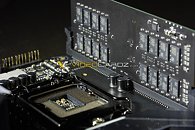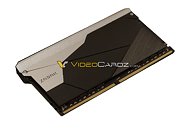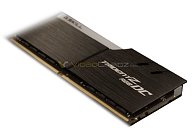- Joined
- Oct 9, 2007
- Messages
- 47,670 (7.43/day)
- Location
- Dublin, Ireland
| System Name | RBMK-1000 |
|---|---|
| Processor | AMD Ryzen 7 5700G |
| Motherboard | Gigabyte B550 AORUS Elite V2 |
| Cooling | DeepCool Gammax L240 V2 |
| Memory | 2x 16GB DDR4-3200 |
| Video Card(s) | Galax RTX 4070 Ti EX |
| Storage | Samsung 990 1TB |
| Display(s) | BenQ 1440p 60 Hz 27-inch |
| Case | Corsair Carbide 100R |
| Audio Device(s) | ASUS SupremeFX S1220A |
| Power Supply | Cooler Master MWE Gold 650W |
| Mouse | ASUS ROG Strix Impact |
| Keyboard | Gamdias Hermes E2 |
| Software | Windows 11 Pro |
32-gigabyte DDR4 UDIMMs are a reality. Samsung recently announced the development of a 32 GB DDR4 dual-rank UDIMM, using higher density DRAM chips. Those chips, however, are unlikely to be available anytime soon, compounded by Samsung's reported scumbaggery in the making. In the midst of all this, motherboard major ASUS designed its own non-JEDEC UDIMM standard, called "Double Capacity DIMM" or DC DIMM, with the likes of G.Skill and Zadak designing the first models. The utility of these modules is to max out the CPU memory controller's limit despite having fewer memory slots on the motherboard. Possible use-cases include LGA1151 mini-ITX motherboards with just one slot per memory channel (2 slots in all), or certain LGA2066 boards with just four slots (one slot per channel).
There is no word on the memory chip configuration modules, but it's highly likely they are dual-rank. The first DDR4 DC modules could be 32 GB, letting you max out the memory controller limit of 8th gen and 9th gen Core processors with just two modules. ASUS is heavily marketing this standard with its upcoming motherboards based on Intel's Z390 Express chipset, so it remains to be seen if other ASUS motherboards (or other motherboards in general) support the standard. Ironically, the Zadak-made module shown in ASUS marketing materials use DRAM chips made by Samsung.



View at TechPowerUp Main Site
There is no word on the memory chip configuration modules, but it's highly likely they are dual-rank. The first DDR4 DC modules could be 32 GB, letting you max out the memory controller limit of 8th gen and 9th gen Core processors with just two modules. ASUS is heavily marketing this standard with its upcoming motherboards based on Intel's Z390 Express chipset, so it remains to be seen if other ASUS motherboards (or other motherboards in general) support the standard. Ironically, the Zadak-made module shown in ASUS marketing materials use DRAM chips made by Samsung.



View at TechPowerUp Main Site






